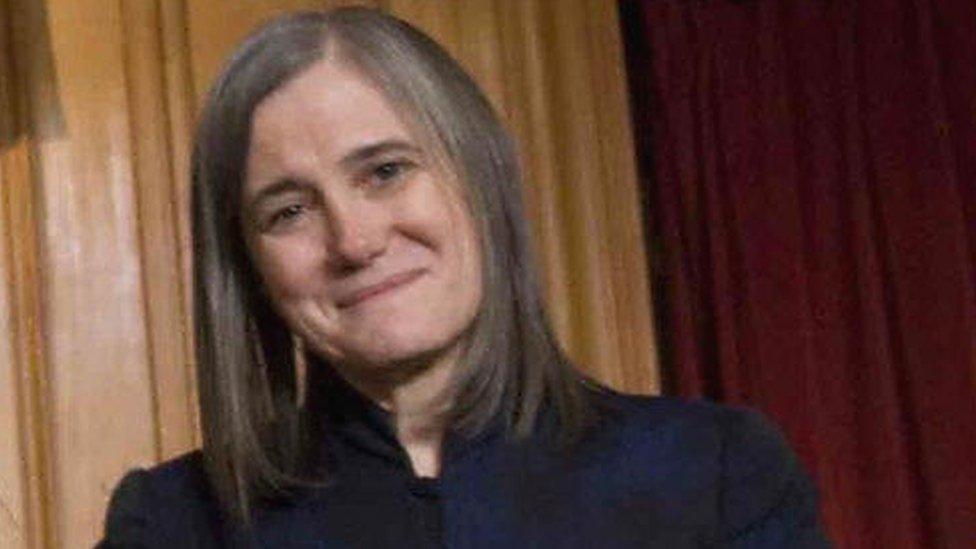Dakota Pipeline: What's behind the controversy?
- Published
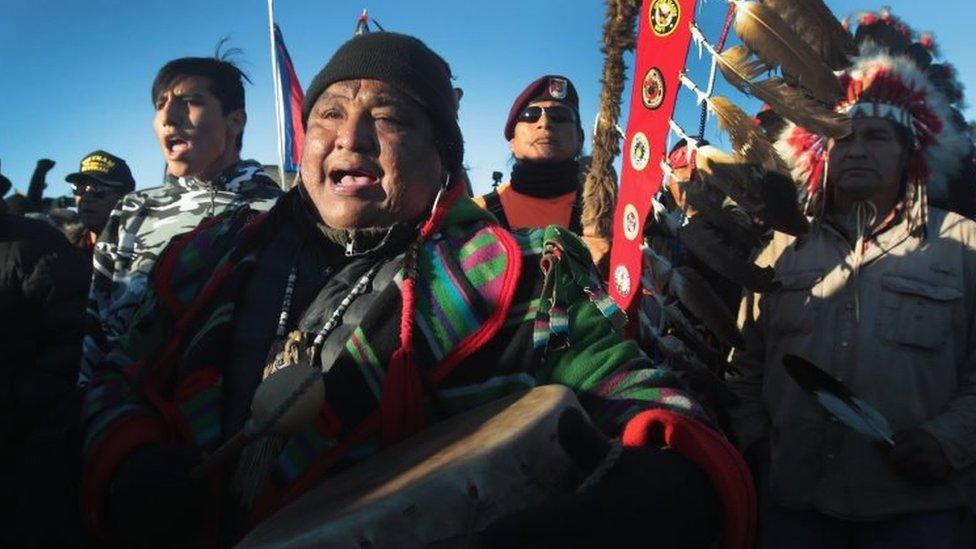
Native American activists celebrated after learning of the US Army's decision last year
Donald Trump's backing of the Dakota Access Pipeline project has set the stage for a new confrontation with native Americans and environmentalists.
Within days of taking office, he signed two presidential memoranda supporting both the Dakota and the Keystone XL pipelines - telling the army to review one, and inviting a private company to re-apply for the other.
What is Dakota Access?
A $3.7bn (£2.8bn) pipeline is planned at nearly 1,200 miles (1,900km) long to transport some 470,000 barrels of crude oil a day across four states, from North Dakota to a terminal in Illinois, where it can be shipped to refineries.
The pipeline would provide a more cost-effective, efficient means of transporting crude, rather than shipping barrels by train.
The project, built by a subsidiary of Texas-based company Energy Transfer Partners (ETP), would also increase profit margins for oil companies while crude prices are low.
Most of the pipeline has already been built but the section closest to the Standing Rock Sioux reservation was still awaiting federal approval.
Why was it suspended?
The decision came after months of protests by the Standing Rock Sioux Tribe and their supporters, who set up a number of spiritual camps - Sacred Stone, external, Oceti Sakowin, Red Warrior, and Rosebud Sicangu - near the Missouri river.
They had argued that the project would contaminate drinking water and damage sacred burial sites.
The US Army Corps of Engineers suspended the project last year, but in February 2017 said it planned to grant final easement for the remaining section of the project.
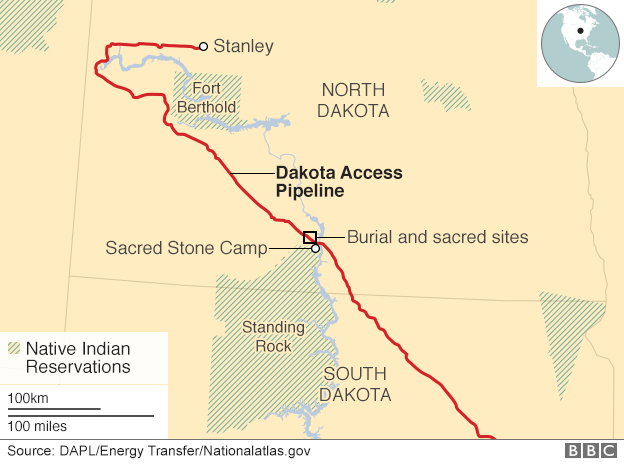
Construction sites are technically just north of the tribe's reservation but the Sioux say the government took this land from them illegally in an 1868 treaty.
Native Americans also accused the government of approving pipeline construction without consulting them, a requirement under US law.
Environmental activists say the pipeline would perpetuate fossil fuel production.
What does Trump's decision mean?
Mr Trump made two different announcements: his backing of both projects in presidential memoranda, and a plan to use American steel in any and all future pipeline projects.
While Mr Trump does not have the power to approve either the Dakota Access or Keystone XL pipelines, his memos offer significant encouragement.
For Dakota, he said, external he believes finishing the pipeline will "serve the national interest" and ordered an "expedited" review. He also ordered the army to "consider" withdrawing its December memo, which effectively paused the project.
On the Keystone XL project, external, he invited the company involved, TransCanada, to resubmit its application, and instructed the secretary of state to "take all actions necessary and appropriate to facilitate its expeditious review".
But Mr Trump can only ease the way with such memos, and prompt their advancement - he cannot single-handedly approve them.
On the same day, he signed another memo, external, ordering the secretary of commerce to produce a plan to use steel and iron made in the United States in all pipeline construction and repair.
The new president may face questions about his personal interest in the Dakota project, as ETP chief executive Kelcy Warren donated $100,000 (£80,000) to his election campaign.
Mr Trump denies he is motivated by any financial interest.
How have opponents of the project reacted?
The Standing Rock Sioux said they would fight the decision.
"Americans know this pipeline was unfairly rerouted towards our nation and without our consent," they said.
Greenpeace director Annie Leonard said that "instead of pushing bogus claims about the potential of pipelines to create jobs, Trump should focus his efforts on the clean energy sector where America's future lives".
Who exactly are the protesters?
More than 200 Native American tribes pledged their support last year, in the largest coming together of indigenous peoples in the US in decades, perhaps centuries.
At its peak, an estimated 10,000 people joined the campsites in the region to join in the demonstrations.
Among others lending their support were :
Green Party presidential candidate Jill Stein and Democratic presidential primary contender Bernie Sanders
Robert Kennedy Jr, environmental activist and nephew of former president John F Kennedy
Several actors including Shailene Woodley and Mark Ruffalo
Have the demonstrations been peaceful?
Protesters have been accused of starting fires and throwing petrol bombs at police.
A Colorado woman who shot at police trying to remove protesters from private property was arrested and charged with attempted murder.
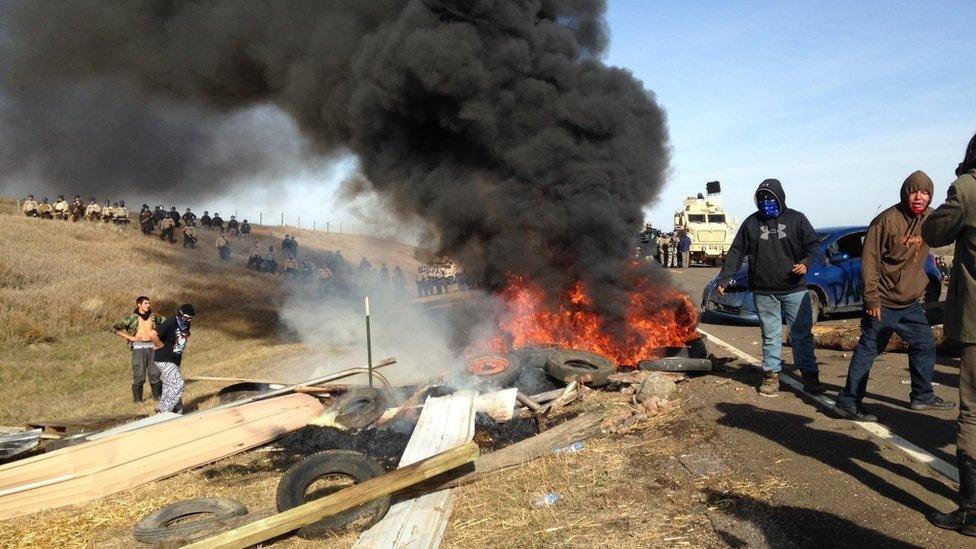
Protesters have tried to block roads
Police have in turn been accused of using excessive force, including dousing crowds with pepper spray and freezing water as well as firing sound cannons, bean bag rounds and rubber bullets.
Officers have arrested hundreds of people and accused activists and journalists of criminal trespass, rioting and other felonies.
At one point, police held protesters in temporary cages made of chain-link, which activists equated to "dog kennels".
The allegations led the United Nations to speak out about the use of excessive force against protesters, external.

Correction: This article has been substantially updated to correct previous inaccuracies.
- Published2 November 2016

- Published2 November 2016
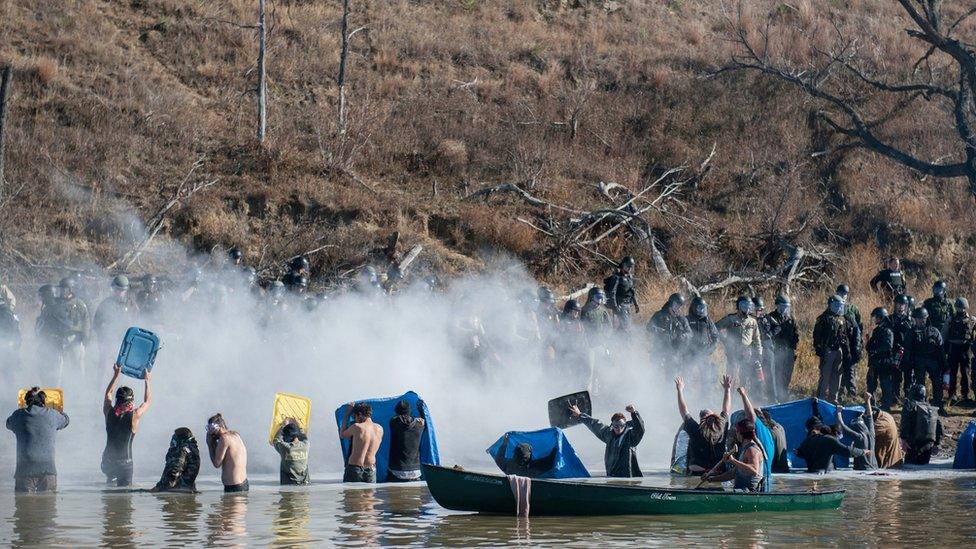
- Published17 October 2016
